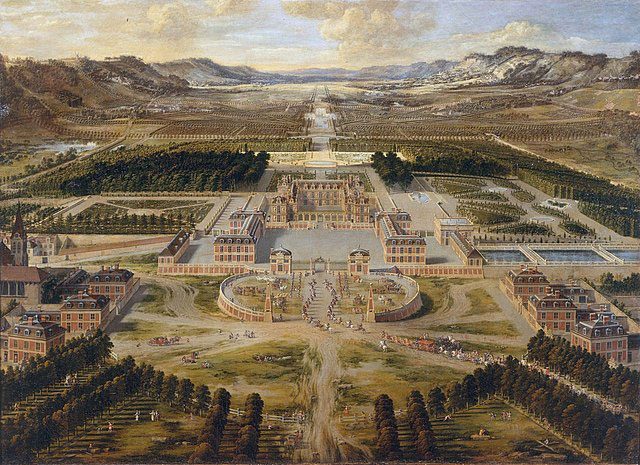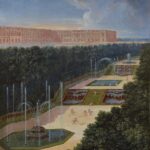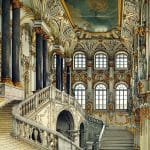
The Palace of Versailles stands as a symbol of grandeur and opulence. For centuries, its majestic halls have witnessed the rise and fall of kings, the intrigues of the French court, and the transformation of a nation. Every year, millions of visitors flock to Versailles, drawn to its rich history and breathtaking beauty. But beneath the surface of this historic palace lies a treasure trove of secrets that even the most seasoned traveler may not know. From hidden passageways to ghostly legends, Versailles is full of mysteries waiting to be uncovered.
While the golden facade of Versailles is often the first thing visitors admire, the true depth of its history can only be found by looking closer. It wasn’t just the residence of Louis XIV and Marie Antoinette. Versailles played a central role in shaping the history of France and Europe. Beyond its magnificent gardens and stunning architecture are hidden rooms, secret escapes, and political dealings that changed the course of history. These secrets are what make the Palace of Versailles not just a tourist destination, but a gateway into the untold stories of France’s royal past.
A Royal Maze: The Hidden Passageways of Versailles
The Palace of Versailles was designed with more than just beauty in mind. Its architecture included secret passageways and hidden rooms to allow the king, his family, and high-ranking officials to move through the palace without being seen. This discreet system allowed the monarchy to control the flow of information and maintain their power while ensuring privacy.
One of the most famous hidden passages was used by King Louis XIV himself. Known as the “Sun King,” Louis XIV made Versailles the center of his court. However, he didn’t always want to be seen by everyone. The palace’s intricate design included private corridors that allowed him to move between his apartments and other parts of the palace unnoticed. This system of passageways ensured that only the king’s closest confidants could reach him directly. It helped maintain the image of the all-powerful king while keeping unwanted visitors at bay.
Even the servants of Versailles had their own secret routes. The “backstairs” were reserved for the servants, allowing them to go about their duties without disturbing the royal family or the guests. These hidden corridors helped the palace run smoothly while maintaining an atmosphere of luxury and exclusivity. Visitors today rarely get to see these passageways, but they played a critical role in the daily life of the palace.
The hidden rooms of Versailles were not just about convenience, though. They also served more secretive purposes. Louis XV, the great-grandson of Louis XIV, had his own set of secret chambers where he would meet with his private advisors and mistresses. These rooms were completely separate from the official chambers and were known only to a select few. The presence of these hidden rooms reveals the often hidden political and personal maneuvering that took place within the palace walls.
Marie Antoinette’s Private World: Escapes and Solitude
Marie Antoinette is one of the most famous figures associated with the Palace of Versailles. Her life was filled with luxury, but also with isolation and misunderstanding. While she lived in the grandeur of Versailles, she often felt trapped by the demands of royal life. To escape the pressures of the court, Marie Antoinette created her own private world within the palace grounds.
The Queen’s Hamlet was one of her most beloved retreats. Located in the vast gardens of Versailles, this small, rustic village was designed to resemble a simple countryside farm. Here, Marie Antoinette would dress in simpler clothes and spend time away from the formality of palace life. It was a place where she could find peace and relax with her close friends. Although it may seem strange for a queen to seek refuge in a farm-like setting, the Queen’s Hamlet was her way of reconnecting with a simpler life.
Marie Antoinette’s desire for privacy extended beyond the Hamlet. She also had secret passageways leading from her private chambers to other parts of the palace. These hidden routes allowed her to move around Versailles without being followed by the court or the press. Some even speculate that she tried to use these passageways during the early days of the French Revolution to escape the growing unrest. However, her attempts to flee were unsuccessful, and she eventually faced imprisonment and execution.
One of the most tragic aspects of Marie Antoinette’s story is her failed attempt to escape during the Revolution. In 1791, she and her family tried to flee to Austria using a hidden route out of Versailles. But they were captured before they could reach safety. This event marked the beginning of the end for the French monarchy. The hidden passageways that once offered her solace became symbols of her inability to escape the fate that awaited her.
Marie Antoinette’s secret escapes and her life of solitude at Versailles reveal a complex woman. She was both a symbol of royalty and a victim of the expectations placed on her. Today, her story continues to fascinate historians and visitors alike.
Ghosts of Versailles: Legends and Haunted Tales
The Palace of Versailles is not only a place of historical significance; it is also home to numerous ghost stories and legends. For centuries, visitors and palace staff have reported strange occurrences within the palace’s grand halls. Some claim that the spirits of the royal family and their servants still haunt Versailles, wandering the corridors in search of something lost.
One of the most famous ghost stories involves Marie Antoinette herself. Many believe that her spirit haunts the gardens of Versailles, where she spent so much of her time. Several visitors have claimed to see a woman dressed in 18th-century clothing walking near the Queen’s Hamlet. These sightings have led to speculation that Marie Antoinette’s spirit remains attached to the place where she found her only moments of peace.
Another well-known haunting is that of the “Phantom of Versailles.” This ghost is believed to be a former servant who died under mysterious circumstances. According to legend, the servant was punished for a crime he didn’t commit and now roams the palace seeking justice. Some say they have seen a shadowy figure in the Hall of Mirrors, while others have heard strange noises echoing through the empty rooms late at night.
Even today, paranormal investigators visit Versailles to explore its haunted reputation. Some have captured unexplained sounds and images, adding to the palace’s air of mystery. Whether you believe in ghosts or not, the stories of haunting at Versailles are part of the palace’s enduring appeal.
The ghostly legends of Versailles reflect the palace’s long and sometimes tragic history. From the opulence of the royal court to the violence of the Revolution, Versailles has seen both triumph and tragedy. It’s no wonder that the spirits of the past might still linger, reminding us of the lives lived and lost within its walls.
Versailles as a Political Stage: Diplomacy and Intrigue
While the Palace of Versailles is best known for its beauty, it was also a place where major political events took place. For centuries, Versailles served as the center of French political life. Kings made decisions that shaped the future of Europe, often behind the closed doors of the palace’s hidden rooms.
During the reign of Louis XIV, Versailles became the heart of French diplomacy. Louis XIV used the palace not just as his residence but as a tool of power. By bringing the French court to Versailles, he kept his nobility close and under control. This helped him strengthen his authority and ensure that he remained the central figure in French politics. The palace’s lavish surroundings were designed to impress foreign dignitaries and show off the wealth and power of France.
One of the most important political events to take place at Versailles was the signing of the Treaty of Versailles in 1919. This treaty officially ended World War I and reshaped the map of Europe. World leaders gathered in the Hall of Mirrors to negotiate the terms of peace. The treaty imposed harsh penalties on Germany and is often cited as one of the causes of World War II. The choice of Versailles as the location for such a significant event underscored its importance in world history.
However, the palace was also the site of more secretive political dealings. In the years leading up to the French Revolution, political intrigue was rampant at Versailles. Many of the decisions that led to the downfall of the monarchy were made in the palace’s private chambers. Louis XVI and his advisors held secret meetings to try to save the monarchy, but their efforts were ultimately unsuccessful. The revolutionaries who stormed Versailles in 1789 brought an end to centuries of royal rule, but the palace remained a symbol of political power.
Even today, Versailles plays a role in modern politics. French presidents often host foreign dignitaries at the palace, continuing its tradition as a symbol of French diplomacy. The history of Versailles as a political stage reminds us that it was not just a place of luxury, but a center of power that shaped the course of history.
The Forgotten Gardens: Versailles’ Hidden Natural Treasures
While the main gardens of Versailles are famous worldwide, few people know about the hidden groves and secluded areas that were reserved for the royal family. These private gardens were designed to offer peace and solitude away from the prying eyes of the court. They also held some of the palace’s best-kept secrets.
One of the lesser-known gardens is the Grove of Apollo, a secluded area tucked away from the main paths. Here, visitors could find beautiful fountains and sculptures that depicted scenes from Greek mythology. This grove was a favorite spot for Louis XIV, who saw himself as a modern-day Apollo, the god of the sun. The symbolism of the grove reflects the king’s desire to connect his reign with divine power.
The Enceladus Fountain is another hidden treasure within the gardens of Versailles. It tells the story of the giant Enceladus, who was buried under a mountain by the gods for rebelling against them. The fountain symbolizes the power of the monarchy and its ability to crush rebellion. This hidden spot was a reminder to visitors of the king’s authority and strength.
There were also private garden rooms, which were used for royal gatherings and events. These small, enclosed spaces provided the royal family with a level of privacy that was not possible in the larger, more public areas of the palace. The gardens were not just a place for relaxation; they were also an extension of the king’s political power, designed to impress and intimidate.
Today, many of these hidden gardens are not part of the regular tourist routes. However, visitors who take the time to explore off the beaten path can still discover these secluded areas. They offer a glimpse into the private world of the French royal family and the secret spaces where history was made.
Art, Architecture, and Hidden Symbolism
The Palace of Versailles is not just a masterpiece of architecture; it is also full of hidden symbols and messages that reflect the power of the French monarchy. Every detail of the palace was carefully designed to reinforce the authority of the king and communicate his divine right to rule. From the layout of the gardens to the art in the Hall of Mirrors, Versailles is a palace full of meaning.
The Hall of Mirrors is one of the most famous rooms in Versailles. It was designed to impress visitors with its stunning reflections and grandeur. But the mirrors were also a symbol of Louis XIV’s power. By reflecting the sunlight, they connected the king to Apollo, the sun god. This was part of Louis XIV’s effort to portray himself as the “Sun King,” whose authority came directly from the gods.
In addition to the Hall of Mirrors, the statues and murals throughout the palace were full of hidden messages. Many of the sculptures depicted mythological figures, such as Hercules and Jupiter, to show the strength and wisdom of the monarchy. The paintings often included allegories of victory, peace, and justice, all of which reinforced the idea that the king was chosen by divine providence.
Even the layout of the gardens had symbolic meaning. The long, straight avenues and symmetrical design reflected the order and control that the king sought to impose on both nature and his subjects. The fountains, which were powered by an innovative system of hydraulics, demonstrated the technological advancements of France and the king’s ability to control even the elements.
These hidden symbols were not just for show; they were part of a larger political message. Louis XIV used Versailles as a way to legitimize his rule and project his power to both his subjects and foreign leaders. Today, visitors can still see these hidden messages, reminding us that Versailles was not just a beautiful palace, but a carefully crafted symbol of absolute monarchy.
The Disappearance of Royal Treasures
One of the most enduring mysteries of the Palace of Versailles is the disappearance of its royal treasures. During the French Revolution, many of the palace’s priceless artifacts were either stolen or destroyed. While some treasures have been recovered, others remain lost to history.
Among the most famous missing treasures are the jewels of Marie Antoinette. Before the revolution, the queen was known for her lavish lifestyle, which included an extensive collection of jewels. When the royal family was imprisoned, many of these jewels were taken. Some were sold to fund the revolutionary cause, while others vanished without a trace. To this day, treasure hunters and historians search for clues about what happened to these priceless gems.
Another lost treasure is the original furniture and artwork that once filled the halls of Versailles. Much of the palace’s original furnishings were auctioned off during the revolution, and many have never been recovered. Some of these pieces have turned up in private collections, while others may still be hidden in forgotten corners of France.
The mystery of the missing treasures adds another layer to the intrigue of Versailles. The palace may still hold secrets that have yet to be uncovered. Whether hidden in private collections or lost forever, the royal treasures of Versailles continue to fascinate historians and collectors alike.
Conclusion
The Palace of Versailles is more than just a symbol of luxury and power. Its walls are filled with stories of intrigue, political maneuvering, and hidden secrets. From the hidden passageways of Louis XIV to the ghostly legends of Marie Antoinette, Versailles offers a glimpse into the lives of the people who shaped French history. The palace’s hidden gardens, lost treasures, and symbolic art remind us that Versailles was not just a place of beauty but a center of power and control.
As historian Charles Tilly once said, “Great historical events leave behind great monuments. Versailles is one of those monuments, standing as a reminder of France’s past and its lasting influence on the world.”




